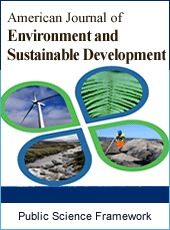American Journal of Environment and Sustainable Development
Articles Information
American Journal of Environment and Sustainable Development, Vol.5, No.1, Mar. 2020, Pub. Date: Jan. 14, 2020
Multi-temporal Landsat Images for Land Use Land Cover Changes in Sinnar State, Sudan
Pages: 1-5 Views: 2048 Downloads: 630
[01]
Eman Osman Saad, Department of Forest Conservation and Protection, Faculty of Forestry, University of Khartoum, Shambat, Sudan.
[02]
Manal Awad Kheiry, Department of Forest Conservation and Protection, Faculty of Forestry, University of Khartoum, Shambat, Sudan.
[03]
Yousif Elnour Yagoub, Department of Forest Conservation and Protection, Faculty of Forestry, University of Khartoum, Shambat, Sudan.
The current paper aims to quantify and describe the spatial and temporal patterns of Land Use Land Cover Change LULCC in Sinnar State - Sudan using Remote sensing RS and GIS technology between 2000 and 2016. Multi-temproal landsat data as well as pixel-based classification were used for analysis. The result was clearly indicated that the largest relative land cover change was the increase of Rain-fed Agriculture RfA and decreasing of forest cover. The result showed that RfA from 2000 to 2016 was increased by approximately from 256719 feddan in 2000 to 297726 feddan in 2016. Meanwhile, the Forest cover was decreased from 28253 feddan in 2000 to 12117 feddan in 2016. It well noticed that the largest relative change for the period 2000 and 2016 in the study area covered by RfA practices. This paper showed successful applications of multi-temporal landsat data and pixel based classification techniques in assessing and mapping the LULC in the study area. In addition, land cover information may also help decision-makers to understand and respond appropriately to emerging environmental risks for the inhabited people.
Landsat Images, Pixel-based Classification, LULCC, Sinnar State-Sudan
[01]
FAO (1997). State of the World’s Forest. Situation and Prospects for Forest Conservation and Development, Italy.
[02]
Read J. M., Lam N. S. N. (2002). Spatial methods for characterizing land cover and detecting land cover changes for the tropics. International Journal of Remote Sensing, 23, 2457-2474.
[03]
Sabins F. F. (1997). Remote sensing, principles and interpretation. (3rd ed). W. H. Freeman and Company, New York.
[04]
MOHAMMED A. H., ZHANG X., ZHU C., WANG S., ZHANG N. (2018). Mapping land cover change in spatial patterns of semi-arid region across West Kordofan, Sudan using Landsat data. APPLIED ECOLOGY AND ENVIRONMENTAL RESEARCH 16 (6): 7925-7936.
[05]
Houet T. P. H. et al. (2010). Monitoring and modeling landscape dynamics. Landscape Ecology. 25, 163-167.
[06]
Yagoub Y. E., Musa O. S., Siddig A. A. H., Zhang B., Li Z. Q., and Wang F. T. (2017). Assessing the Impacts of Land Use Changes on Vegetation Cover in Eastern Sudan. International Journal of Research in Agricultural Sciences. 4, 2348-3997.
[07]
Dimyati M., Mizuno K., Kitamura T. (1996). An analysis of land use/cover change using the combination of MSS Landsat and land use map: a case study in Yogyakarta, Indonesia. Inter. J. Rem. Sen. 17, 931-944.
[08]
Muttitanon W., Tripathi N. K. (2005). Land use/land cover changes in the coastal zone of Ban Don Bay, Thailand using Landsat 5 TM data. International Journal of Remote Sensing 26, 2311-2324.
[09]
Capizzi G., Sciuto G. L., Woźniak M., Damaševicius R. (2016). A clustering based system for automated oil spill detection by satellite remote sensing. In International Conference on Artificial Intelligence and Soft Computing (pp. 613-623). Springer, Cham.
[10]
Foody G. M. (2003). Remote sensing of tropical forest environments: towards the monitoring of environmental resources for sustainable development. International Journal of Remote Sensing. 24, 4035-4046.
[11]
Hill J., Schütt B., (2000): Mapping complex patterns of erosion and stability in dry Mediterranean ecosystems. Remote Sensing of Environment 74, 557-569.
[12]
Lambin, E. F., Turner, B. L., Geist, H. J., Agbola, S. B., Angelsen, A., Bruce, J. W., &... & Xu, J. (2001). The causes of land-use and land-cover change: moving beyond the myths. Global Environmental Change, 11 (4), 261-269. https://doi.org/10.1016/S0959-3780 (01)00007-3.
[13]
Mohamed A. E., Elhadi H. M., Adam Y. O., Eisa M. A. (2014). Payment for Environmental Services (PES): A mechanism for adopting the agroforestry farming system among gum Arabic producers in Sudan. International Journal of Development and Sustainability 3, 1099-1112.
[14]
IFAD (2010). Supporting the Small-scale traditional rainfed producers in Sinnar State, Sudan. Pp 35.
[15]
Ahmed A. E., Abdelsalam S. M., Siddig K. H. (2012). Do grain reserves necessarily contribute to prices stability and food security in Sudan? An assessment. Journal of the Saudi Society of Agricultural Sciences. 11, 143-148.
[16]
Sam A. K., Elmahadi M. M. (2008). Assessment of absorbed dose rate in air over plowed arable lands in Sinnar State, central Sudan. Radiation Protection Dosimetry 129, 473-477.
[17]
Peterson D. L., Egbert S. L., Price K. P., Martinko E. A., (2004). Identifying historical and recent land-cover changes in Kansas using post-classification change detection techniques. Transactions of the Kansas Academy of Science, 107 (3/4), 105- 118.
[18]
Sulieman H. M., Buchroithner M. F. (2009). Degradation and Abandonment of Mechanized Rain-Fed AgriculturalLand in the Southern Gadarif Region, Sudan. The Local Farmers’ Perception. Land Degradation and Development. 20, 199-209.
[19]
Yagoub Y. E., Zhang B., Ji D. M., Jahelnabi A. E., Fadoul S. M. (2015). Land Use and Land Cover Change in Northeast Gadarif State: Case of El Rawashda Forest, Sudan. Journal of Geographic Information System. 7, 140-157.
[20]
Bandit Mienmany (2018). Analysis of land use and land cover changes and the driving forces: A case study in Kaysone Phomvihan District, Laos. Dissertation of Master in Geographic Information Systems and Spatial Planning. Faculty of Arts, University of Porto.

ISSN Print: Pending
ISSN Online: Pending
Current Issue:
Vol. 6, Issue 4, December Submit a Manuscript Join Editorial Board Join Reviewer Team
ISSN Online: Pending
Current Issue:
Vol. 6, Issue 4, December Submit a Manuscript Join Editorial Board Join Reviewer Team
| About This Journal |
| All Issues |
| Open Access |
| Indexing |
| Payment Information |
| Author Guidelines |
| Review Process |
| Publication Ethics |
| Editorial Board |
| Peer Reviewers |


